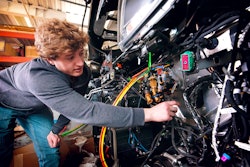The trucking industry is navigating complex terrain marked by fluctuating demand for freight movement. From global shippers to local delivery services, the need to transport products quickly and cost-effectively remains a constant. While overall growth is forecasted for the market, there is room for improvement.
The recently released WorkHound 2024 Trends in Trucking Report sheds light on the issues impacting the frontline workers responsible for keeping things moving. A strong supply chain is the undeniable backbone of the economy; solving these issues effectively ensures our ability to build and maintain a vibrant economy and enjoy the prosperity that comes along with it.
The good news is that the key issues identified in the report can be addressed, and in most cases, solutions are available today from companies specializing in logistics efficiency. The critical element is technology, but navigating the endless array of available options can be a mind-numbing experience.
The key findings in the report, and what to consider as you evaluate potential solutions, can be broken out into a handful of primary categories:
People
According to the report, “operational issues such as poor planning, inefficient load assignments, and issues with maintenance and equipment can drive a wedge between the workforce and management. Workers often feel these inefficiencies impact their ability to work effectively and safely.”What to look for: There are technology solutions available today for managing operational inefficiencies that make the job harder and have the potential to alienate workers. These well-crafted technologies allow dispatchers to efficiently plan their drivers’ trips, track their progress and provide real-time updates once a driver is assigned.
Dispatch
Miscommunication, micromanagement and lack of support are among the dispatch-related concerns noted in the report. Workers are vocal about their frustrations regarding communication gaps that impact their work and their schedules.What to look for: Solving the age-old dispatch challenge in the trucking industry is within reach. What you need is a platform that’s specifically designed to promote seamless communication. The best examples will provide a method that eliminates the need for any other channel of communication between the dispatcher and driver. Rather than a stop-gap technology that addresses one specific issue, it’s best to consider a solution that was developed as an end-to-end platform.
Financial implications
Truck drivers and owner-operators are directly impacted by operational decisions, such as inefficient routes and manual processes. They’re acutely aware that their performance and earning potential are greatly diminished.What to look for: The best way to alleviate this concern is to integrate a technology that gives dispatchers and drivers tools to plan the most efficient routes. The technology exists, and it can resolve more than a few headaches for all involved.
Logistics
Load management and planning issues continue to plague the industry. WorkHound’s research found that “workers vented frustrations with load assignments and planning, pointing out the need for more efficient operational strategies.”What to look for: Before you invest in technology that can help address and resolve these concerns, look for a solution that prioritizes smart features. There are transportation management platforms available that enable clear trip planning, dispatching of assignments, and incorporate in-transit load updates for both shippers and carriers. The best solutions will include a user-friendly app that drivers can use for two-way communication and data transfer from the field.
Work/life balance
Personal concerns rank high on drivers’ priority lists. Poor scheduling has a deep impact on their lives, and the report noted that these challenges are “often accompanied by feelings of disrespect and a sense of being devalued.”What to look for: The good news is that this issue is eminently solvable. When evaluating your options, always prioritize a technology that allows for efficient route planning. Even better, some platforms provide automatic updates for heavily manual processes such as invoice generation, which lets drivers focus on the higher-value work they enjoy.
The insights from the report highlight the need to tackle issues facing the trucking industry. By focusing on technologies that enhance operational efficiency, improve communication between dispatchers and drivers, optimize route planning, and support work/life balance, the industry can overcome many of its current hurdles.













